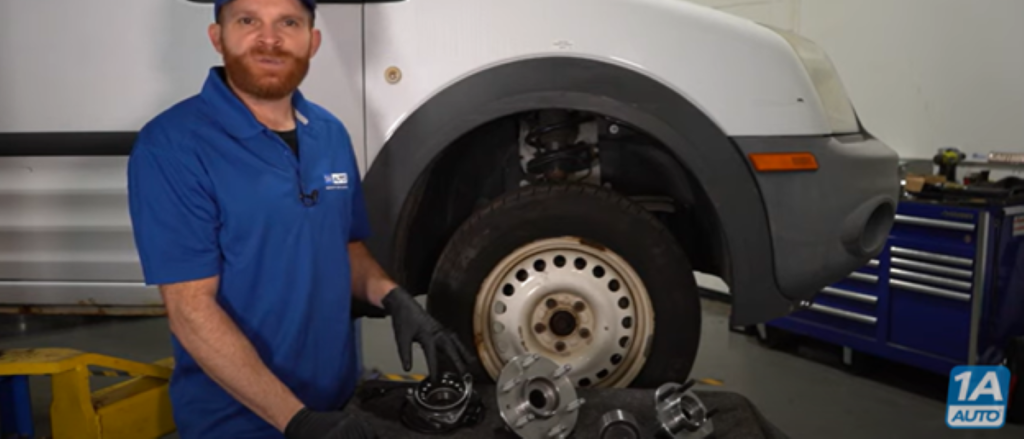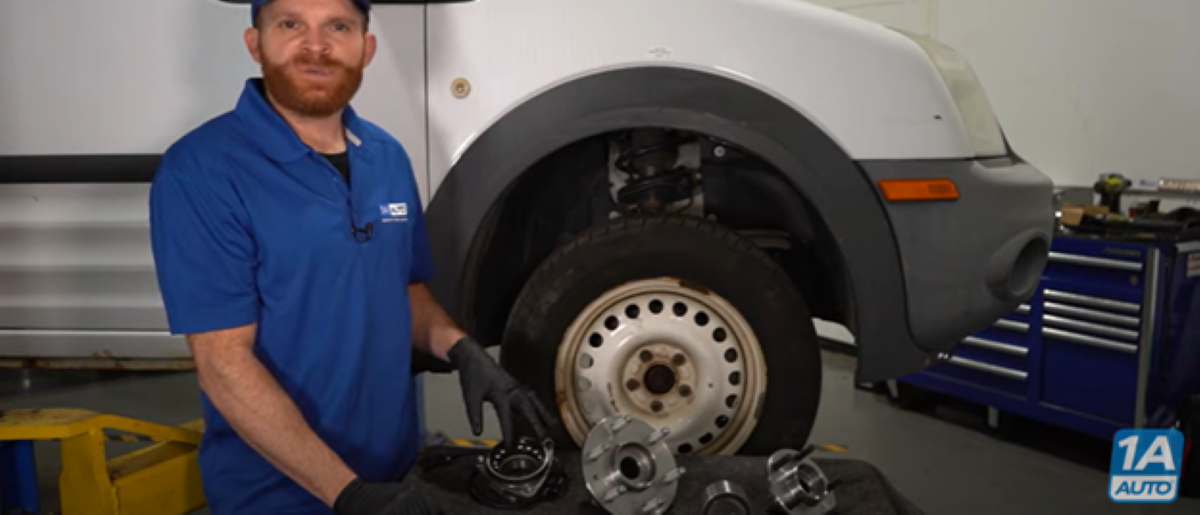Learn expert wheel hub assembly replacement tips and how ignoring this repair can cause more problems with your vehicle. Find out how to replace a wheel hub assembly yourself and more.
What Is a Wheel Bearing?

The wheel hub bearing helps the tires spin and move your vehicle forward down the road. It attaches to the knuckle and wheel, and has a bearing to spin with the tire. Depending on your vehicle, there are sealed press-in bearings that press into the steering knuckle, and there are wheel hub assemblies that consist of a wheel hub that attaches to a bearing and which bolts on to the knuckle.
More on wheel bearing and hub assemblies
How Do I Know I Need a Wheel Hub Assembly Replacement?
Grinding, Humming, or Clunking Noise from the Wheel

Wheel hubs can fail for different reasons. The bearing has ball or roller bearings. Ball bearings are most commonly used for the front wheels. Ball bearings sit in the bearing behind a seal. If the seal breaks, for example, the greased ball bearings will delubricate over time, rust from moisture, and eventually seize the bearing. As the bearing wears out, it can make a grinding noise.
More on a humming noise from the wheel
You’ll typically hear the humming noise while turning. The humming noise will come from the bad bearing on the opposite side that you’re turning to. For example, if you’re turning right (passenger side), you’ll hear the humming noise from the wheel on left (driver side). This is because the weight shifts to the other side of the vehicle, puts more load on the worn bearing, and it creates a noise.
More on how to tell which wheel bearing is bad while driving
An extreme case covered in the video above at 4:30 could cause the wheel and brake rotor to move around. The rotor could hit against the brake caliper bracket and make a grinding noise from the contact.
The front end may make a clunking noise when driving over bumps if it has a bad wheel bearing. There are many different front end parts that can make this noise when they’re defective.
More on a clunking noise while driving over bumps
Vehicle Pulls to the Left or Right
A bad wheel bearing could pull your vehicle to the left or right when driving down the road. The bad wheel bearing assembly could cause the wheel to shake around or angle it inward or outward and pull the car in that direction.
More on diagnosing a car pulling to the right or left
Uneven Tire Wear
One possible cause of uneven tire wear is a bad wheel bearing. As the tire is pulled in a certain direction while the bearing is bad, this off-kiltering can cause the tire to wear on one side more than the other.
More on how to check tire tread
ABS or Traction Control Light Turns on
The ABS light could turn on because of a bad wheel bearing. Most modern vehicles have an ABS system that tracks how fast the wheel spins. A worn bearing assembly with an ABS sensor can turn the light on if there’s an issue with one of the assembly’s components. The traction control light could also turn on if there’s an issue with the wheel bearing. It’s a sign that more than likely there’s a problem with the wheel bearing and hub assembly if both of these lights turn on.
More on diagnosing an ABS light
Excessively Loose Wheel Hub Bearing
Excessive looseness is one sign of a defective wheel hub assembly. You can raise and secure the vehicle with a jack and jack stands to check the wheel bearing. Grab the tire from the 12 and 6 or 3 and 9 o’clock position and press it in and out, feeling for an excessively loose bearing. These generally mean there’s a problem with it, especially if it’s from both of those angles. It’s also important to check the other front end parts like the tie rods and ball joint.
More on how to diagnose bad wheel bearings
More on how to diagnose front end parts
Binding Wheel
As the bearing wears from use, heat and friction can cause binding. You can test for this by jacking up the vehicle and spinning the tire, feeling for restriction. The tire should spin smoothly.
More on the signs of bad wheel bearings
Why You Want to Install a Wheel Hub Assembly Replacement as Soon as You Need It

It Can Wear Your Brake Parts Faster
Brake parts like the rotors and pads can wear faster if you don’t install a wheel hub assembly replacement as soon as needed. If your car has a worn bearing, it can cause the brake rotor to wobble around. This can cause uneven wear on the brake pads and rotor. It can also hit against the brake calipers. In extreme cases it could cause brake pulsation.
It Can Damage Suspension Parts
A wheel hub assembly that needs a new replacement could damage suspension parts if it’s not changed soon enough. Typically you’ll have an upper and lower ball joint and tie rod ends. If the wheel is able to jump around enough from the shaking caused by a worn bearing, these parts can wear out from excessive movement. It can also wear out the axle that attaches to the hub assembly.
It Can Disconnect from the Wheel
In cases of extreme use, a badly worn wheel bearing could break away from the wheel if not replaced once it’s defective. This would be an unsafe situation for you and other drivers.
Read: Is It Safe to Drive with a Bad Wheel Bearing?
DIY Wheel Hub Assembly Replacement Tips
This video covers typical steps for installing a wheel hub assembly replacement that bolts to the steering knuckle.
A press-in bearing repair is more in depth than a bolt-on bearing one. You’ll still need to raise and secure the vehicle and remove the brake parts. Then you’ll need to remove the entire steering knuckle and press out the hub and bearing with a press.
General steps for a wheel hub assembly replacement
- Remove the Wheel
Loosen the lug nuts with the vehicle on the ground
Remove the cotter pin from the axle nut if it has one
Loosen the axle nut
Raise the vehicle with a floor jack
Secure the vehicle on jack stands
Remove the lug nuts
Remove the wheel - Remove the Brake Pads
Remove the bolts from the caliper bracket
Pull the caliper off
Put the caliper aside
Pry the brake pads off with a flat blade screwdriver - Remove the Brake Rotor
Remove the two bolts from the caliper bracket
Pull off the brake caliper bracket
Remove a screw from the rotor if it has one
Strike the drum surface of the rotor with a hammer to loosen the rotor
Pull the rotor off
Clean the hub surface with a wire brush - Install the Brake Pads
Place the brake pads into the caliper bracket
Apply grease to the brake pads
Push back the caliper piston with groove-lock pliers
Put the brake caliper into place
Reinsert the two bolts into the caliper
Torque the two bolts - Reattach the Wheel
Slide the wheel into place
Start the lug nuts by hand
Tighten the lug nuts preliminarily
Lower the vehicle to the ground
Torque the lug nuts in a crossing or star pattern
Torque the axle nut - Get a Professional Alignment
After you’ve completed this repair, have a professional alignment done. This will fix any changes to the alignment and prevent early tire wear.
How-to Videos for Automotive DIY Repairs
Learn how to do more than replace a wheel hub assembly with our how-to videos. Step-by-step instructions, expert tips, and more can help DIYers of all skill levels work on many different vehicles.
Shop Quality Auto Parts – Wheel Hub Assembly Replacements and More


